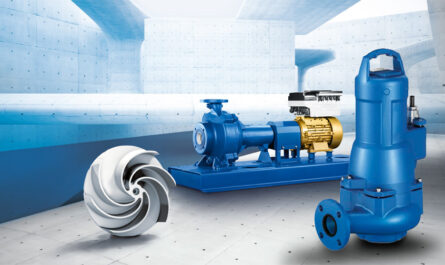Centrifugal pumps work on the principle of centrifugal force. When a fluid enters the pump impeller eye, the rotating impeller imparts velocity to the fluid and throws it outward due to centrifugal force. As the fluid moves outward, its kinetic energy is converted into pressure energy. This increases the pressure of the fluid and causes it to flow out of the discharge port from where it is sent to the application.
Types of Centrifugal Pumps
There are various kinds of Centrifugal Pump available depending on their construction and application. Some of the major types are:
– Single Stage Pump: As the name suggests, it has only one impeller to boost the pressure in one stage. These pumps are used for low-pressure applications where head requirement is less than 30 meters.
– Multi Stage Pump: When high discharge pressure is required, multiple impellers are used arranged in series. Each impeller increases the pressure in steps resulting in high overall discharge pressure. Commonly used where head requirement is more than 100 meters.
– Vertical Pump: Used where space is a constraint. The motor, shaft and impeller are arranged vertically. Commonly used in water supply from wells and borewells.
– Submersible Pump: Specially made to work submerged in water. Entire motor and pump components are contained in a waterproof casing. Ideal for drainage applications and underground water supply.
– Monobloc Pump: A compact design where the hydraulic part and electric motor are integrated as a single piece without alignment issues. Commonly used in domestic water supply.
Working Parts of a Centrifugal Pump
The major components that work together to transfer fluid in a Centrifugal Pump include:
– Casing: It is the exterior housing that encloses the internal parts of the pump. Usually made of cast iron, it has inlet and outlet ports for fluid.
– Impeller: Manufactured from aluminium or iron alloys, it resembles a fan or wheel with vanes. When rotated centrifugally, it increases the pressure of the fluid.
– Shaft: Serves to transmit motion from the motor to the impeller. It is supported by bearings at both ends to withstand thrust in rotation.
– Gasket: Provided at mating surfaces of casing and other parts to prevent leakage of fluid. Usually made from rubber or synthetic material.
– Bearings: Allow smooth rotation of shaft under load. Ball or roller type bearings are used depending on application load.
– Seal: Provided at shaft exit to prevent leakage of pumped fluid into the motor chamber. Mechanical seals or stuffing box arrangements are commonly used.
Applications of Centrifugal Pump
Given their simple and robust construction, centrifugal pumps have widespread applications in industries as well as daily life. Some key application areas include:
– Cooling Water Systems: Used for circulating large volumes of water as coolant in power plants, heavy machinery, HVAC systems etc.
– Water Supply: Municipal water distribution, irrigation systems, water treatment plants extensively use centrifugal pumps for bulk water transfer.
– Marine Systems: Used for bilge and ballast water transfer in ships. Also commonly employed in marine coolant circulation systems.
– Fire Fighting: High pressure multi-stage centrifugal pumps are essential equipment for fire engines and sprinkler systems.
– Industrial Processes: Found in almost all chemical and process industries for liquid transfer in applications like oil & gas extraction, pulp and paper plants etc.
– Swimming Pools: Variable speed pumps are becoming popular for swimming pool filtration and recirculation applications.
So in summary, modern industries would be incomplete without centrifugal pumps that form the backbone of fluid transfer applications across various mission critical processes. Their reliability along with simple design has made them ubiquitous workhorses in the fluid handling sector.
Maintenance and Troubleshooting of Centrifugal Pumps
No matter how robustly a centrifugal pump is designed and built, some maintenance and repairs become necessary over time due to continuous operation. Here are some key points regarding periodic checks and troubleshooting:
– Check foundation bolts, coupling alignment and ensure tightness to avoid vibration related damage.
– Inspect impeller, casing and wear rings for signs of corrosion or abrasion. Replace worn out parts.
– Flush and clean pump routinely to remove accumulated solids that cause reduced performance.
– Lubricate bearings and check oil level periodically according to manufacturer manual.
– Examine mechanical seals for scratches. Replace if leaking noticed around shaft area.
– Monitor pump parameters like flow, pressure, temperature and current draw. Compare with nameplate ratings.
– Troubleshoot noisy operation, loss of pressure head, unusual heating or vibration by examining individual components.
With systematic maintenance, routine inspections and addressing issues promptly; centrifugal pumps can deliver years of carefree, trouble-free operational life. Their low maintenance cost along with high reliability makes them the preferred choice for moving liquids across a wide spectrum of industries.
*Note:
1. Source: Coherent Market Insights, Public sources, Desk research
2. We have leveraged AI tools to mine information and compile it
About Author - Vaagisha Singh
Vaagisha brings over three years of expertise as a content editor in the market research domain. Originally a creative writer, she discovered her passion for editing, combining her flair for writing with a meticulous eye for detail. Her ability to craft and refine compelling content makes her an invaluable asset in delivering polished and engaging write-ups. LinkedIn


 by
by 


